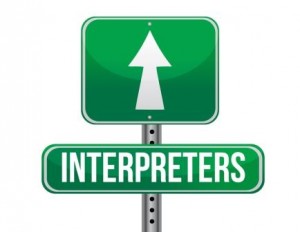
You know the feeling…wishing you could speak the family’s language so you can build that strong relationship that’s so important in early intervention (EI). It can be challenging to coach a family when you have a language barrier, but a good interpreter can help you overcome that challenge. I recently met a new colleague with a background in language interpretation who told me that a sign of a good interpreter is when he/she is “invisible.” This really made an impression on me because when you think about it, the interpreter offers a bridge for communication and in his/her role, is invisible as an outside contributor to the interaction. The interpreter should be sure that the people on either side of the bridge fully understand each other without adding extraneous information or taking over the interaction. Understandably, that must be hard for the interpreter, but remaining that invisible bridge is important so that he/she doesn’t actually end up being a roadblock in the relationship-building between the family and the interventionist.
VIDEO: Collaborating with Language Interpreters – Information for Home Visitors
Take 5 minutes and watch this video:
One of my favorite phrases from this video is: Add nothing, omit nothing, change nothing. I like this phrase because I think this is what early interventionists want. We want to know exactly what the parent said and we want the parent to know exactly what we said. Yes, the actual words interpreted may change to ensure the meaning is conveyed, but that’s okay. It is when information is added, omitted, or changed that the relationship is affected. Here are some of the other key take-aways from the video that can have a positive effect on building the interventionist-parent relationship:
Speak with the interpreter before the visit – Get to know each other and explain what will happen on the visit. Review the purpose of the meeting and roles during the meeting. Share any guidelines from your program for how to work together.
Allow for additional time – Be patient and plan ahead so you have enough time for the extra communication involved.
Sit in a triangle – You should face the parent, and the interpreter should sit so he/she can see and speak with both you and the parent.
Always look at and speak directly to the parent – This is often the hardest one for interventionists. It can feel a bit awkward, but you should be sure to look at the parent when you speak to him/her. Remember the invisible bridge. If you speak and look directly at the interpreter, he/she is no longer invisible.
Keep it short and remember to pause – This one is also hard because shortening your sentences and remembering to pause may not be how you normally talk. It can take some getting used to and requires a mindful approach to communication, but makes it easier for the interpreter to accurately share everything you say.
Collaborating with the interpreter as an invisible bridge takes its own relationship-building, between you and the interpreter. Once that relationship is established, you will have a wonderful resource and partner who is essential in helping you help families.
What strategies do you use to build relationships with families when collaborating with a language interpreter?
What are your thoughts on the idea of the interpreter being an invisible bridge?
Share your comments below!
For information you can share with interpreters, visit the VEIPD Cultural Competence topic page and look under the Handouts/Documents tab for links to Resources for Interpreters Working in Early Intervention (EITP, University of Illinois).



This is great information and I love the video! Here is a link to the Early Intervention Training Program at the University of Illinois “Working with Interpreters” Resource Page: https://blogs.illinois.edu/view/6039/406781. This blog post will be a great addition to this resource page and there may even be some additional tips/resources that others who read this blog might be interested in checking out.
Thanks Sarah, I’m so glad you dropped this link in! Lots of great resources on your site that readers can use to dive deeper into this topic. 🙂
I recently had an experience with sign language interpreters at a national conference where I was presenting. Two participants in my audience were deaf. Two sign language interpreters took turns translating and both did an excellent job being that bridge. They also reminded me as I was moving around the room a bit, not to block their direct view to the participants. I had to really think about looking directly at the participants when they were participating in discussions because, as noted, there is a natural tendency to want to look at the translator. Great blog. Thanks.